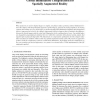Free Online Productivity Tools
i2Speak
i2Symbol
i2OCR
iTex2Img
iWeb2Print
iWeb2Shot
i2Type
iPdf2Split
iPdf2Merge
i2Bopomofo
i2Arabic
i2Style
i2Image
i2PDF
iLatex2Rtf
Sci2ools
EUROGRAPHICS
2010
Eurographics
2010
Eurographics
Global Illumination Compensation for Spatially Augmented Reality
When projectors are used to display images on complex, non-planar surface geometry, indirect illumination between the surfaces will disrupt the ļ¬nal appearance of this imagery, generally increasing brightness, decreasing contrast, and washing out colors. In this paper we predict through global illumination simulation this unintentional indirect component and solve for the optimal compensated projection imagery that will minimize the difference between the desired imagery and the actual total illumination in the resulting physical scene. Our method makes use of quadratic programming to minimize this error within the constraints of the physical system, namely, that negative light is physically impossible. We demonstrate our compensation optimization in both computer simulation and physical validation within a table-top spatially augmented reality system. We present an application of these results for visualization of interior architectural illumination. To facilitate interactive modiļ...
Actual Total Illumination | Computer Graphics | EUROGRAPHICS 2010 | Global Illumination Simulation | Indirect Illumination |
| Added | 11 Mar 2010 |
| Updated | 15 Mar 2010 |
| Type | Conference |
| Year | 2010 |
| Where | EUROGRAPHICS |
| Authors | Yu Sheng, Theodore C. Yapo, Barbara Cutler |
Comments (0)

